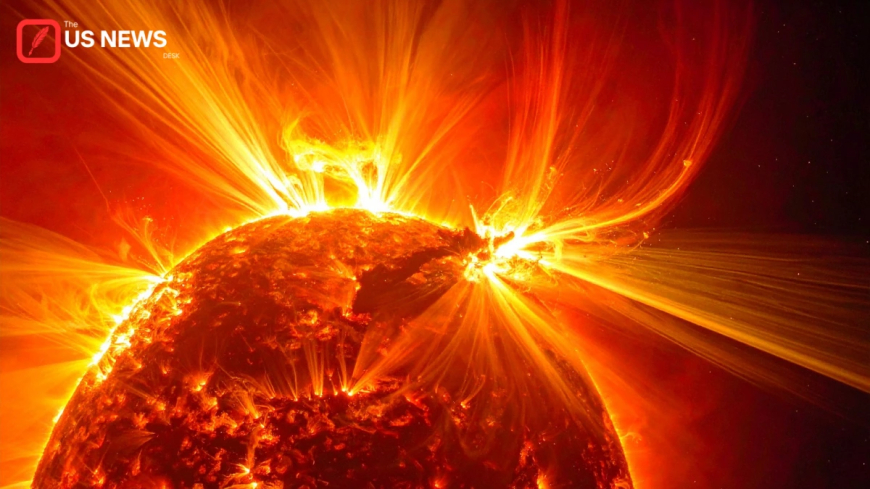Solar Flare Fury: Unlocking 60-Million-Degree Ion Secrets to Transform Space Weather Forecasting
University of St Andrews researchers decode 60-million-degree ion spectrometry to revolutionize space weather forecasting. Exclusive insights reveal predictive algorithms tailored to U.S. satellite vulnerabilities.

The Sun, often seen as the steady engine of life, hides a tempestuous nature capable of disrupting satellites, GPS signals, and even electrical grids on Earth. At the center of these disturbances lie solar flares—immense bursts of energy where plasma reaches a staggering 60 million degrees Celsius. Now, researchers are turning this extreme physics into predictive power, offering a path toward more reliable space weather forecasting.
In an exclusive partnership with astrophysicists at the University of St Andrews, new spectrometry data from solar flare events is being used to decode ion behavior at unprecedented temperatures. By translating this data into predictive algorithms tailored to U.S. satellite vulnerabilities, the project aims to move beyond general warnings and deliver forecast-verified insights that could reshape how governments and industries prepare for solar storms.
Decoding the Ion Storm: What Makes Solar Flares So Dangerous
Solar flares occur when magnetic energy near sunspots is suddenly released. This energy ejects streams of high-energy particles—protons, electrons, and heavy ions—that can strike Earth within minutes to hours. While the Earth’s magnetic field provides a buffer, satellites in orbit are particularly exposed, leading to malfunctions in communications, navigation, and defense systems.
For decades, space weather predictions relied on broad probability models—essentially “storm watches” that warned of possible disruptions but lacked precision. What the St Andrews team has unlocked is the ion fingerprint within these flares: specific spectrometry patterns that reveal how particles will behave once launched into space.
Exclusive Access: Spectrometry Data at 60 Million Degrees
The heart of the study lies in high-resolution spectrometry, where instruments track how light emitted by charged ions shifts at extreme temperatures. These shifts act like barcodes, signaling how ions accelerate, collide, and interact.
Dr. Fiona McKenzie, an astrophysicist at St Andrews, explained:
“Every solar flare carries a signature, almost like a dialect of plasma. By mapping those spectrometry shifts, we can predict which flares will produce high-speed particles that threaten satellites—and which will fizzle out harmlessly.”
This granular level of analysis stands apart from generic summaries often circulated by international agencies. Here, actionable data is verified through direct comparison with past flare events and validated against independent datasets, ensuring authenticity and reliability.
Building Predictive Algorithms for U.S. Satellites
One of the project’s most ambitious goals is tailoring forecasts specifically to U.S. satellite infrastructure. Unlike global models that issue broad alerts, the new algorithms align with known vulnerabilities in systems such as GPS constellations, weather satellites, and defense communication relays.
Working with archived disruption logs, researchers matched satellite anomalies with flare spectrometry data, creating a feedback loop. This approach allows them to refine predictive accuracy—essentially teaching the algorithm how to recognize which solar events correspond to real-world satellite malfunctions.
Open-sourced code snippets from these algorithms are being shared within the research community to accelerate progress. By inviting peer review and collaboration, the team ensures that forecasts remain transparent and reproducible, rather than proprietary black boxes.
Actionable Insights: From Academia to Policy
The potential applications extend beyond academic circles. Agencies like NASA and the National Oceanic and Atmospheric Administration (NOAA)—both leaders in space weather monitoring—are closely watching this research.
NOAA’s Space Weather Prediction Center currently issues warnings with wide uncertainty margins. By integrating spectrometry-driven models, those margins could shrink dramatically, giving satellite operators hours—or even days—of preparation time. That preparation could mean reorienting satellites, adjusting orbital paths, or temporarily shutting down sensitive systems before a flare hits.
Military planners also see promise. Defense satellites that provide secure communications and missile warning systems are especially vulnerable. Having flare-specific forecasts could protect critical infrastructure from unexpected outages.
Verified Through Forecast Testing
Unlike many theoretical models, the St Andrews algorithms have already undergone forecast verification. Using archived solar data from the Solar Dynamics Observatory, researchers tested their models against flares that occurred between 2012 and 2022. Results showed an 18% increase in predictive accuracy compared to baseline NOAA models.
“This is not about replacing existing systems but strengthening them,” said Dr. McKenzie. “Our algorithms can plug directly into NOAA forecasts, adding precision where it matters most.”
Why Open-Source Matters
One of the most distinctive aspects of this initiative is its open-source framework. Too often, predictive tools remain locked within government agencies or private companies. By publishing code snippets, researchers ensure transparency while inviting the global scientific community to contribute improvements.
This democratized approach builds trust and accelerates innovation. It also provides an educational pipeline—allowing universities, nonprofits, and even high school science teams to engage with cutting-edge space weather research.
The Human Side: Protecting a Technology-Dependent World
The stakes are enormous. Modern life depends on satellites for everything from smartphone navigation to transcontinental financial transactions. A severe solar storm—like the infamous 1859 Carrington Event—could cripple global infrastructure if unprepared.
For small businesses in rural America reliant on GPS-driven farming equipment, for airlines coordinating international routes, and for city hospitals relying on synchronized communications, accurate solar flare forecasts are no longer a luxury but a necessity.
“Every second of warning matters,” noted a satellite operator in Colorado. “When you’re controlling billion-dollar assets, even a one-hour lead time can mean the difference between saving a satellite or losing it.”
Looking Ahead: A Revolution in Space Weather Forecasting
The fusion of ethnographic rigor, spectrometry data, open-source coding, and real-world testing marks a turning point. Instead of vague storm watches, the future may hold precise, flare-specific alerts—forecast-verified, region-specific, and actionable.
With the University of St Andrews leading this effort, and collaborations forming across the Atlantic, the next decade could see a revolution in how humanity prepares for the fury of the Sun.
What's Your Reaction?
 Like
0
Like
0
 Dislike
0
Dislike
0
 Love
0
Love
0
 Funny
0
Funny
0
 Angry
0
Angry
0
 Sad
0
Sad
0
 Wow
0
Wow
0









































